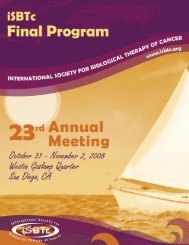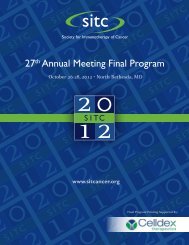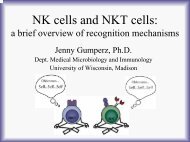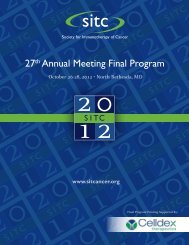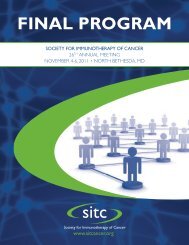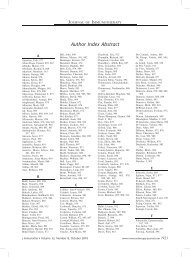Abstracts for the 25th Annual Scientific Meeting of the International ...
Abstracts for the 25th Annual Scientific Meeting of the International ...
Abstracts for the 25th Annual Scientific Meeting of the International ...
You also want an ePaper? Increase the reach of your titles
YUMPU automatically turns print PDFs into web optimized ePapers that Google loves.
J Immuno<strong>the</strong>r Volume 33, Number 8, October 2010<br />
<strong>Abstracts</strong><br />
responses through <strong>the</strong> capacity to degrade <strong>the</strong> essential amino-acid<br />
tryptophan into kynurenine and o<strong>the</strong>r downstream metabolites<br />
that suppress effector T cell function and favour <strong>the</strong> differentiation<br />
<strong>of</strong> regulatory T cells. IDO can be expressed by a variety <strong>of</strong> cell<br />
types, including dendritic cells (DC), tumor cells and stromal cells.<br />
IDO is widely dysregulated in tumors and tumor-draining lymph<br />
nodes, where it can mediate immune tolerance to tumor antigens<br />
and facilitate immune escape. Recently, we showed that IDO itself<br />
is subject to cellular immune responses. Hence, spontaneous<br />
cytotoxic T cell reactivity against IDO is present in peripheral<br />
blood as well as in <strong>the</strong> tumor microenvironment <strong>of</strong> different cancer<br />
patients. We demonstrated that <strong>the</strong>se IDO reactive T cells are<br />
indeed peptide specific, cytotoxic effector cells. Hence, IDO reactive<br />
T cells are able to recognize and kill tumor cells including directly<br />
isolated AML blasts as well as IDO-expressing dendritic cells, that<br />
is, one <strong>of</strong> <strong>the</strong> major immune suppressive cell populations.<br />
Consequently, IDO may serve as an important and widely<br />
applicable target <strong>for</strong> anti-cancer immuno<strong>the</strong>rapeutic strategies.<br />
Here, we describe that spontaneous cytotoxic T cell reactivity<br />
against IDO also exists in healthy individuals. We show that such<br />
IDO-specific T cells boost immunity against viral antigens by<br />
eliminating IDO+ suppressive cells. This has pr<strong>of</strong>ound effects on<br />
<strong>the</strong> balance between IL-17-producing CD4+ T cells and regulatory<br />
T cells. Fur<strong>the</strong>rmore, IDO-specific T cells can be induced in healthy<br />
individuals by non-specific inflammatory stimuli such as IFN-g and<br />
IL-2. In <strong>the</strong> clinical setting, IDO may serve as an important and<br />
widely applicable target <strong>for</strong> immuno<strong>the</strong>rapeutic strategies where<br />
IDO constitute a significant counter-regulatory mechanism induced<br />
by pro-inflammatory signals. Regulatory T cells have so far been<br />
defined as a specialized subpopulation <strong>of</strong> T cells that act as<br />
suppressor T cells. However, here we describe effector T cells with a<br />
general regulatory function that may play a vital role <strong>for</strong> <strong>the</strong><br />
mounting or keeping <strong>of</strong> an effective adaptive immune response.<br />
Pentostatin Plus Cyclophosphamide to Eliminate Immunogenicity<br />
<strong>of</strong> Anti-Meso<strong>the</strong>lin Immunotoxin (SS1P)<br />
Justin Taylor, Miriam E. Mossoba, Paul R. Massey, Masanori<br />
Onda, Ira Pastan, Daniel H. Fowler. National Cancer Institute,<br />
Be<strong>the</strong>sda, MD.<br />
The immunotoxin (IT) SS1P is composed <strong>of</strong> an anti-meso<strong>the</strong>lin<br />
Fv fused to a 38 kDa fragment <strong>of</strong> Pseudomonas exotoxin A and is<br />
being evaluated in meso<strong>the</strong>lioma and lung cancer. But in<br />
meso<strong>the</strong>lioma patients, neutralizing antibodies develop after 1<br />
cycle <strong>of</strong> <strong>the</strong>rapy, <strong>the</strong>reby preventing additional treatment cycles. IT<br />
<strong>the</strong>rapy has been shown to be effective in hairy cell leukemia, where<br />
multiple cycles can be given without neutralizing antibody<br />
<strong>for</strong>mation. This lack <strong>of</strong> immunogenicity may result from immune<br />
dysfunction, ei<strong>the</strong>r from <strong>the</strong> disorder itself or from previous<br />
immune depleting <strong>the</strong>rapy. In this study, our aim was to determine<br />
if using chemo<strong>the</strong>rapy to dysregulate <strong>the</strong> immune system,<br />
specifically comparing immune depletion to immune suppression,<br />
might abrogate immunogenicity. BALB/c mice were injected with<br />
10 mg SS1P weekly <strong>for</strong> 3 weeks and serum was evaluated <strong>for</strong><br />
neutralizing antibodies at <strong>the</strong> end <strong>of</strong> each week. An immune<br />
depletion group was treated <strong>for</strong> six days prior to <strong>the</strong> first IT<br />
immunization with daily cyclophosphamide (50 mg/kg/d) and<br />
pentostatin (1 mg/kg/d) every o<strong>the</strong>r day, followed by weekly<br />
maintenance doses <strong>of</strong> P/C one day prior to immunization. An<br />
immune suppression group was treated on an every o<strong>the</strong>r day<br />
schedule <strong>of</strong> rapamycin (3 mg/kg/d) <strong>for</strong> <strong>the</strong> entire post-immunization<br />
period. Three weeks after <strong>the</strong> first immunization spleen cells<br />
were isolated, counted and analyzed by flow cytometry to<br />
determine <strong>the</strong> levels <strong>of</strong> depletion <strong>of</strong> CD4+ and CD8+ T cells,<br />
B cells (B220+), and myeloid cells (Gr-1+). Immunogenicity was<br />
determined by presence <strong>of</strong> antibodies to SS1P by ELISA (DC) or<br />
con<strong>for</strong>mational ELISA (ICC) assays. Both <strong>the</strong> regimens <strong>of</strong> P/C and<br />
R were safe and well tolerated in <strong>the</strong> mice in terms <strong>of</strong> weight loss<br />
and survival. The P/C regimen markedly depleted both T and<br />
B cells with relative sparing <strong>of</strong> myeloid cells. Readouts <strong>of</strong><br />
immunogenicity by <strong>the</strong> ICC assay showed 5/10 mice developed<br />
antibodies in <strong>the</strong> IT only group, while no mice (0/10) developed<br />
antibodies in ei<strong>the</strong>r <strong>the</strong> P/C and R treated groups. However, <strong>the</strong> DC<br />
assay revealed 3/10 mice treated with R indeed had anti-SS1P<br />
antibodies present but 0/10 P/C-treated mice showed immunogenicity.<br />
Although immune suppression by treatment with rapamycin<br />
did cause reduced immunogenicity, antibodies to <strong>the</strong> anti-meso<strong>the</strong>lin<br />
IT were detectable at low levels. On <strong>the</strong> o<strong>the</strong>r hand, immune<br />
depletion with pentostatin plus cyclophosphamide prevented <strong>for</strong>mation<br />
<strong>of</strong> any detectable IT-targeted antibodies. These findings will<br />
allow <strong>for</strong> <strong>the</strong> investigation <strong>of</strong> immune depletion with <strong>the</strong>se drugs as a<br />
mechanism to overcome immunogenicity in treatment <strong>of</strong> meso<strong>the</strong>lioma<br />
with <strong>the</strong> immunotoxin SSIP. Since meso<strong>the</strong>lin is also<br />
expressed on lung, ovarian and pancreatic cancer, results could be<br />
applicable to treatment <strong>of</strong> <strong>the</strong>se more common cancers as well.<br />
Humanization <strong>of</strong> a High Affinity, Neutralizing Antibody<br />
Against Hepatitis B Surface Antigen<br />
Ashutosh Tiwari*, Navin Khannaw, Subrata Sinha*. *Biochemistry,<br />
All India Institute <strong>of</strong> Medical Sciences; w Recombinant Gene Product<br />
Lab, <strong>International</strong> Center <strong>for</strong> Genetic Engineering and Biotechnology,<br />
New Delhi, India.<br />
Hepatitis B virus chronically infect more than 500 million people<br />
worldwide and account <strong>for</strong> about two-thirds <strong>of</strong> all hepatocellular<br />
carcinoma, <strong>the</strong> third most common cause <strong>of</strong> cancer-related death.<br />
Universal vaccination using Hepatitis B surface antigen (HBsAg) is<br />
a possible way to achieve eradication <strong>of</strong> <strong>the</strong> disease. However,<br />
alternative strategies to combat hepatitis B are needed because <strong>of</strong><br />
<strong>the</strong> existence <strong>of</strong> vaccine non-responders, emergence <strong>of</strong> viral escape<br />
mutants and <strong>the</strong> persistence <strong>of</strong> a subpopulation <strong>of</strong> viral carriers in<br />
developing countries. We previously generated a potentially<br />
neutralizing mouse monoclonal antibody (5S) against HBsAg.<br />
This antibody showed very high affinity and stable binding in<br />
presence <strong>of</strong> different agents that usually destabilize antigenantibody<br />
interactions. In this report we describe <strong>the</strong> humanization<br />
<strong>of</strong> 5S antibody by grafting its antigen binding site onto framework<br />
<strong>of</strong> <strong>the</strong> human consensus sequence <strong>of</strong> highest similarity. We have<br />
used molecular modeling to alter not only <strong>the</strong> clearly permissible<br />
residues but also several minimal positional template and VH/VL<br />
interface residues. The humanized antibody retained a high binding<br />
affinity (KD = 1.27 nmol/L) to HBsAg and bound to <strong>the</strong> same<br />
epitope <strong>of</strong> HBsAg as <strong>the</strong> parent molecule. This high affinity<br />
humanized antibody provides a basis <strong>for</strong> <strong>the</strong> development <strong>of</strong><br />
<strong>the</strong>rapeutic molecules that can be safely utilized <strong>for</strong> <strong>the</strong> prophylaxis<br />
and treatment <strong>for</strong> Hepatitis B infection.<br />
Development <strong>of</strong> Cancer Stem Cell Vaccine<br />
Toshihiko Torigoe, Yoshihiko Hirohashi, Akari Takahashi,<br />
Satoshi Nishizawa, Rena Morita, Satoko Inoda, Noriyuki Sato.<br />
Department <strong>of</strong> Pathology, Sapporo Medical University, Sapporo,<br />
Japan.<br />
Cancer stem cells (CSCs), a small population <strong>of</strong> cancer cells with<br />
stem cell-like phenotype and tumor-initiating capacity, are<br />
important targets <strong>for</strong> cancer <strong>the</strong>rapy because <strong>the</strong>y may be<br />
responsible <strong>for</strong> recurrence after chemo<strong>the</strong>rapy. We are exploring<br />
<strong>the</strong> possibility <strong>for</strong> development <strong>of</strong> cancer vaccine targeting CSCs.<br />
In order to clarify immunopathological properties <strong>of</strong> CSCs, CSCs<br />
with high tumor-initiating capacity were collected from various<br />
cancer cell lines by sorting a side population (SP), which has a<br />
capacity to pump out Hoechst 33342 dye through ABC transporters.<br />
By comparative gene expression analysis <strong>of</strong> SP and main<br />
population (MP) cells derived from lung, breast and colon cancer<br />
cell lines, several CSC genes were identified, including SOX2,<br />
SMCP, DNAJB8 and OR7C1. These genes were expressed preferentially<br />
in SP cells, but barely detected in normal adult tissues<br />
except <strong>for</strong> testis. Overexpression <strong>of</strong> <strong>the</strong> genes increased tumorinitiating<br />
capacity <strong>of</strong> cancer cells in vivo, whereas RNAi-mediated<br />
r 2010 Lippincott Williams & Wilkins www.immuno<strong>the</strong>rapy-journal.com | 911



